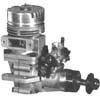

 |

|
|

Fox Eagle Series Engines |

Larger view |
Eagle I .60
Bore: .907
Stroke: .937
Disp: .604
Wt: 14oz |
This cross-flow
scavenged, 2-ringed engine was introduced in the early 70's with
production continuing into the early 80's. Early engines incorporated
an exhaust baffle coupled to the throttle arm of the carburetor
which helped retain heat for a better idle. This feature disappeared
in 1974 since the use of mufflers had become more common and
made the exhaust baffle redundant. External appearance remained
pretty much unchanged over the years although internal improvements
included an enlarged lower end, bushed con rod and head design
changes. In the last few years the engine was also equipped with
the MKX series carburetor. Distinctive features included an eagle
emblem cast into the rear cover and American flag on the side
of the crankcase. A good engine requiring no modifications, except
perhaps updating the carb. on earlier versions. |

Larger view |
Eagle II .60
Bore: .907
Stroke: .937
Disp: .604
Wt: 17oz.
HP: 1.9 at 15,000 RPM |
Introduced
in the late 70's, the Eagle II was a radical departure from the
first Eagle .60. Incorporating an usual 3-piece crankcase design,
this new Eagle also featured a single high tension ring, schneurle
porting, a removable head button and massive internal construction
for durability. High compression often resulted in operating
and reliability problems, so modifications are sometimes necessary.
More Info |

Larger
view |
Eagle II Racing
Bore: .907
Stroke: .937
Disp: .604
Wt: 17oz. |
The Eagle II
was also available in a rear intake, rear exhaust "racing"
version. Unique concepts included a one piece rotor disc and
shaft to maintain squareness with the mating surface. The large
diameter case permitted a larger than average rotor disc and
larger than average intake. Note: very few of these were ever
produced. |

Larger view |
Eagle III .60
Bore: .907
Stroke: .937
Disp: .604
Wt: 17oz. |
The Eagle III
version was introduced in 1980 with a slightly modified crankcase
and numerous internal changes including: a re-designed piston,
shorter con rod, improved porting, new head button, heavier duty
rear bearing and improved taper lock and thrust washer. The old
2-jet carburetor was also replaced with the newer two-needle
MKX series. Still, compression problems remained and sometimes
modifications are required to achieve reliable operation, particularly
with nitro content over 5%.
More Info |

Larger view |
Eagle III .60 Rear Exhaust
Bore: .907
Stroke: .937
Disp: .604
Wt: 17oz. |
While the cylinder
casting of the standard Eagle can also be rotated for rear exhaust
applications, the true Rear Exhaust model was also ported for
tuned pipe operation. Fox claimed 16,000RPM on and 11x7 prop. |

Larger
view |
Eagle IV .60 & .74
|
60 Size |
74 Size |
Bore: .907
Stroke: .937
Disp: .604
Wt: 19oz. |
Bore: 1.00
Stroke: .937
Disp: .736
Wt: 19oz. |
|
|
Significant costs involved in
machining the split crankcase used on the Eagle II and III, necessitated
a change to maintain an acceptable profit margin. Thus, the Eagle
IV was born and remains the current version.
The IV features a conventional,
single piece crankcase, however the separate cylinder is retained.
Also new was the introduction of a .74 version. Both the .60
and .74 were once offered in ringed and ABC versions. The .60
still is, but the .74 is now only available with a ring. Over
compression still tends to be a problem, particularly in earlier
models. There have been at least five head button variations
in an attempt to tame handling! Modifications may still be required
for reliable operation.
More Info
Early Eagle IV's were supplied
with the MKX series carb., while current engines use the EZ series
carburetor. There have been some problems with the EZ series
carburetor, particularly on the larger Fox engines. Modifications
may be necessary to correct an overly lean midrange.
More Info |
|